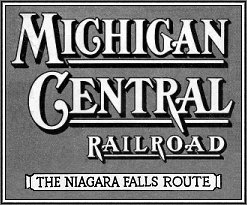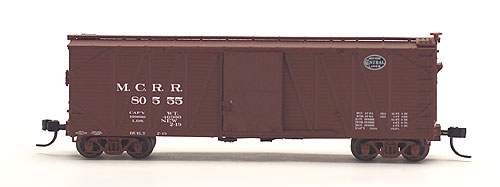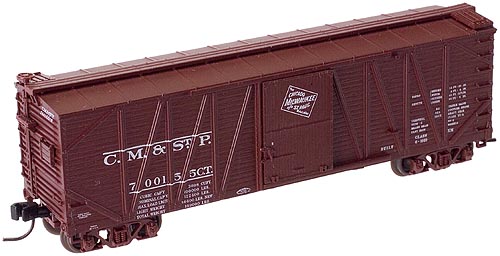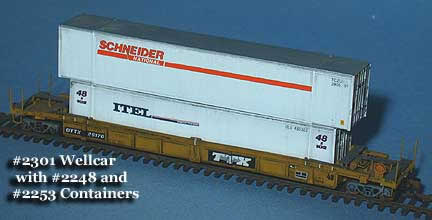Road Name History:  The MCRR was established in 1846 to acquire the state owned Central Railroad of Michigan, a poorly constructed line between Detroit and Kalamazoo, Michigan. Terms of the deal included replacing the cheap rail on the existing line and continuing construction west to Lake Michigan. It was assumed that cargo for Chicago would then be forwarded via lake boat. MCRR did build to the lake at New Buffalo (and not St. Joseph as intended by the state) because the new owners wanted to get to Chicago on their own rails and New Buffalo was on the way. Railroads were acquired to cross the corner of Indiana and into Illinois. The last few miles of the 270 mile line into Chicago were on trackage rights on Illinois Central. Service from Chicago to Detroit opened in 1852. After about 1867 the railroad was controlled by the New York Central Railroad.
The MCRR was established in 1846 to acquire the state owned Central Railroad of Michigan, a poorly constructed line between Detroit and Kalamazoo, Michigan. Terms of the deal included replacing the cheap rail on the existing line and continuing construction west to Lake Michigan. It was assumed that cargo for Chicago would then be forwarded via lake boat. MCRR did build to the lake at New Buffalo (and not St. Joseph as intended by the state) because the new owners wanted to get to Chicago on their own rails and New Buffalo was on the way. Railroads were acquired to cross the corner of Indiana and into Illinois. The last few miles of the 270 mile line into Chicago were on trackage rights on Illinois Central. Service from Chicago to Detroit opened in 1852. After about 1867 the railroad was controlled by the New York Central Railroad.
Vanderbilt interests had been buying shares in MCRR since 1869 and had been trying to acquire the Great Western Railway between Niagara Falls, New York and Windsor, Ontario (just across the river from Detroit.) The goal was to have a second through route between Buffalo and Chicago. Vanderbilt was rebuffed by Great Western and instead began acquiring shares of Canada Southern which accomplished the same goals. In 1882, he arranged for Michigan Central to lease the Canada Southern. MCRR also built and acquired routes to Grand Rapids, Bay City and all the way to Mackinaw City at the northern tip of Michigan’s lower peninsula. In Chicago, MCRR used Illinois Central’s Central Station rather than LaSalle Street Station used by NYC’s other subsidiaries in the city. As early as 1904, New York Central Lines logos began appearing on Michigan Central cars.
Prior to the automobile age, much of the freight traffic originated on the MCRR was tied to the forestry trade. The transformation of Detroit into a center of manufacturing also affected the MCRR with huge volumes of raw materials headed for the city and finished goods moving out.
The Detroit River crossing had become a bottleneck. In 1905, a fleet of four MCRR car ferries were moving on average a thousand cars per day between the U.S. and Canada. In 1910, a new tunnel was opened under the river. The line was electrified to avoid the obvious issues of running steam locomotives thorugh such a long bore. MCRR would acquire a fleet of six Alco GE 1200hp electric locomotives for this service. In 1930 Michigan Central was leased by New York Central, relegating it to the status of paper railroad.
Text Courtesy of Craig Ross of Bluford Shops

Vanderbilt interests had been buying shares in MCRR since 1869 and had been trying to acquire the Great Western Railway between Niagara Falls, New York and Windsor, Ontario (just across the river from Detroit.) The goal was to have a second through route between Buffalo and Chicago. Vanderbilt was rebuffed by Great Western and instead began acquiring shares of Canada Southern which accomplished the same goals. In 1882, he arranged for Michigan Central to lease the Canada Southern. MCRR also built and acquired routes to Grand Rapids, Bay City and all the way to Mackinaw City at the northern tip of Michigan’s lower peninsula. In Chicago, MCRR used Illinois Central’s Central Station rather than LaSalle Street Station used by NYC’s other subsidiaries in the city. As early as 1904, New York Central Lines logos began appearing on Michigan Central cars.
Prior to the automobile age, much of the freight traffic originated on the MCRR was tied to the forestry trade. The transformation of Detroit into a center of manufacturing also affected the MCRR with huge volumes of raw materials headed for the city and finished goods moving out.
The Detroit River crossing had become a bottleneck. In 1905, a fleet of four MCRR car ferries were moving on average a thousand cars per day between the U.S. and Canada. In 1910, a new tunnel was opened under the river. The line was electrified to avoid the obvious issues of running steam locomotives thorugh such a long bore. MCRR would acquire a fleet of six Alco GE 1200hp electric locomotives for this service. In 1930 Michigan Central was leased by New York Central, relegating it to the status of paper railroad.
Text Courtesy of Craig Ross of Bluford Shops
Brand/Importer Information: In 1924 Stephan Schaffan, Sr. founded the Atlas Tool Company in Newark, New Jersey. In 1933 his son, Stephan Schaffan, Jr., came to work for his father at the age of sixteen. Steve Jr. built model airplanes as a hobby and frequented a local hobby shop. Being an enterprising young man, he would often ask the owner if there was anything he could do to earn some extra spending money. Tired of listening to his requests, the hobby-store owner threw some model railroad track parts his way and said, "Here, see if you can improve on this".
In those days, railroad modelers had to assemble and build everything from scratch. Steve Jr. created a "switch kit" which sold so well, that the entire family worked on them in the basement at night, while doing business as usual in the machine shop during the day.
Subsequently, Steve Jr. engineered the stapling of rail to fiber track, along with inventing the first practical rail joiner and pre-assembled turnouts and flexible track. All of these products, and more, helped to popularize model railroading and assisted in the creation of a mass-market hobby. The budding entrepreneur quickly outgrew the limitations of a basement and small garage operation. Realizing they could actually make a living selling track and related products, Steve and his father had the first factory built in Hillside, New Jersey at 413 Florence Avenue in 1947. On September 30, 1949, the Atlas Tool Company was officially incorporated as a New Jersey company.
In 1985, Steve was honored posthumously for his inventions by the Model Railroad Industry Association and was inducted into the Model Railroad Industry Hall of Fame in Baltimore, Maryland. In addition, Steve was nominated and entered into the National Model Railroad Association Pioneers of Model Railroading in 1995.
In the early 1990s, the Atlas Tool Company changed its name to Atlas Model Railroad Company, Inc.
In those days, railroad modelers had to assemble and build everything from scratch. Steve Jr. created a "switch kit" which sold so well, that the entire family worked on them in the basement at night, while doing business as usual in the machine shop during the day.
Subsequently, Steve Jr. engineered the stapling of rail to fiber track, along with inventing the first practical rail joiner and pre-assembled turnouts and flexible track. All of these products, and more, helped to popularize model railroading and assisted in the creation of a mass-market hobby. The budding entrepreneur quickly outgrew the limitations of a basement and small garage operation. Realizing they could actually make a living selling track and related products, Steve and his father had the first factory built in Hillside, New Jersey at 413 Florence Avenue in 1947. On September 30, 1949, the Atlas Tool Company was officially incorporated as a New Jersey company.
In 1985, Steve was honored posthumously for his inventions by the Model Railroad Industry Association and was inducted into the Model Railroad Industry Hall of Fame in Baltimore, Maryland. In addition, Steve was nominated and entered into the National Model Railroad Association Pioneers of Model Railroading in 1995.
In the early 1990s, the Atlas Tool Company changed its name to Atlas Model Railroad Company, Inc.
Item created by: trainnut3500 on 2016-08-03 15:55:53. Last edited by trainnut3500 on 2016-08-03 18:55:53
If you see errors or missing data in this entry, please feel free to log in and edit it. Anyone with a Gmail account can log in instantly.
If you see errors or missing data in this entry, please feel free to log in and edit it. Anyone with a Gmail account can log in instantly.








